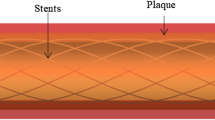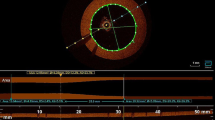Abstract
Purpose
In-stent restenosis (ISR) is related to local haemodynamics in the arteries after stent intervention. However, the haemodynamics of stents implanted into tapered vessels is rarely studied and remains unclear. This study aimed to study the haemodynamic performance of a stent in a tapered artery to reveal the haemodynamic differences between tapered and cylindrical stents after stent implantation and guide the stent selection for the treatment of coronary artery stenosis.
Methods
Cylindrical and tapered stents were implanted into the tapered arteries. A model of a cylindrical stent implanted into a cylindrical artery was established as the contrast model. Using the finite element method, the flow velocity and wall shear stress distribution of the three models were compared.
Results
At t1, t2, t3 and t4, the flow rate of the tapered artery with tapered stents (TT) after the implantation increased by 8.59, 3.80, 12.81 and 3.66%, respectively. In addition, the wall shear stress in the tapered arteries of TT was 23.48, 36.67, 13.00 and 8.06% higher than that of the tapered arteries with cylindrical stents (TC).
Conclusions
The implantation of a tapered stent in the tapered artery can effectively improve intravascular haemodynamics. The tapered stent allows the tapered artery to obtain better haemodynamics and reduces the probability of ISR.




Similar content being viewed by others
References
Balossino, R., F. Gervaso, F. Migliavacca, and G. Dubini. Effects of different stent designs on local haemodynamicss in stented arteries. J. Biomech. 41:1053–1061, 2008.
Beier, S., J. Ormiston, M. Webster, J. Cater, S. Norris, P. Medrano-Gracia, et al. Haemodynamicss in idealized stented coronary arteries: important stent design considerations. Ann. Biomed. Eng. 44:315–329, 2015.
Beier, S., J. Ormiston, M. Webster, J. Cater, S. Norris, P. Medrano-Gracia, et al. Impact of bifurcation angle and other anatomical characteristics on blood flow: a computational study of non-stented and stented coronary arteries. J. Biomech. 49:1570–1582, 2016.
Beier, S., J. Ormiston, M. Webster, J. Cater, S. Norris, P. Medrano-Gracia, et al. Haemodynamicss in idealized stented coronary arteries: important stent design considerations. Ann. Biomed. Eng. 44:315–329, 2016.
Benard, N., D. Coisne, E. Donal, and R. Perrault. Experimental study of laminar blood flow through an artery treated by a stent implantation: characterisation of intra-stent wall shear stress. J. Biomech. 36:991–998, 2003.
Chen, H. Y., J. Hermiller, A. K. Sinha, M. Sturek, L. Zhu, and G. S. Kassab. Effects of stent sizing on endothelial and vessel wall stress: potential mechanisms for in-stent restenosis. J. Appl. Physiol. 106:1686–1691, 2009.
Chiastra, C., F. Migliavacca, M. A. Martínez, and M. Malve. On the necessity of modelling fluid–structure interaction for stented coronary arteries. J. Mech. Behav. Biomed. 34:217–230, 2014.
Chiastra, C., S. Morlacchi, D. Gallo, U. Morbiducci, R. Cárdenes, I. Larrabide, et al. Computational fluid dynamic simulations of image-based stented coronary bifurcation models. J. R. Soc. Interface 10(84):20130193, 2013.
Davies, P. F. Haemodynamics shear stress and the endothelium in cardiovascular pathophysiology. Nat. Clin. Pract. Card. 6:16–26, 2009.
Fu, W., Z. Gu, X. Meng, B. Chu, and A. Qiao. Numerical simulation of haemodynamicss in stented internal carotid aneurysm based on patient-specific model. J. Biomech. 43:1337–1342, 2010.
Gu, L., S. Zhao, and S. R. Froemming. Arterial wall mechanics and clinical implications after coronary stenting: comparisons of three stent designs. Int. J. Appl. Mech. 4:1250013, 2012.
Haghighi, A. R., M. S. Asl, and M. Kiyasatfar. Mathematical modeling of unsteady blood flow through elastic tapered artery with overlapping stenosis. J. Braz. Soc. Mech. Sci. 37:571–578, 2015.
Hsiao, H. M., Y. H. Chiu, K. H. Lee, and C. H. Lin. Computational modeling of effects of intravascular stent design on key mechanical and haemodynamics behavior. Comput. Aided Des. 44:757–765, 2012.
Imani, M., A. M. Goudarzi, D. D. Ganji, and A. L. Aghili. The comprehensive finite element model for stenting: the influence of stent design on the outcome after coronary stent placemen. J. Theor. Appl. Mech. 51:639–648, 2013.
Inoue, T., K. Croce, T. Morooka, M. Sakuma, K. Node, and D. I. Simon. Vascular inflammation and repair: implications for reendothelialization, restenosis, and stent thrombosis. J. Mech. Behav. Biomed. 4:1057–1066, 2011.
Kastrati, A., W. Koch, P. B. Berger, J. Mehilli, K. Stephenson, F. Neumann, et al. Protective role against restenosis from an interleukin-1 receptor antagonist gene polymorphism in patients treated with coronary stenting. J. Am. Coll. Cardiol. 36:2168–2173, 2000.
Koskinas, K. C., Y. S. Chatzizisis, A. P. Antoniadis, and G. D. Giannoglou. Role of endothelial shear stress in stent restenosis and thrombosis: pathophysiologic mechanisms and implications for clinical translation. J. Am. Coll. Cardiol. 59(15):1337–1349, 2012.
Liu, M., A. Sun, and X. Deng. Haemodynamics performance within crossed stent grafts: computational and experimental study on the effect of cross position and angle. Biomed. Eng. OnLine. 17:85, 2018.
Liu, G. T., X. J. Wang, B. Q. Ai, and L. G. Liu. Numerical study of pulsating flow through a tapered artery with stenosis. Chin. J. Phys. 42:401–409, 2004.
Mekheimer, K. S., and M. A. El Kot. Mathematical modelling of unsteady flow of a Sisko fluid through an anisotropically tapered elastic arteries with time-variant overlapping stenosis. Appl. Math. Model. 36(11):5393–5407, 2012.
Mitra, A. K., and D. K. Agrawal. In stent restenosis: bane of the stent era. J. Clin. Pathol. 59:232–239, 2006.
Moore, J. E., and J. L. Berry. Fluid and solid mechanical implications of vascular stenting. Ann. Biomed. Eng. 30:498–508, 2002.
Pant, S., N. W. Bressloff, A. I. Forrester, and N. Curzen. The influence of strut-connectors in stented vessels: a comparison of pulsatile flow through five coronary stents. Ann. Biomed. Eng. 38:1893–1907, 2010.
Qiao, A., and Z. Zhang. Numerical simulation of vertebral artery stenosis treated with different stents. J. Biomech. 136:041007, 2014.
Rikhtegar, F., C. Wyss, K. S. Stok, D. Poulikakos, R. Müller, and V. Kurtcuoglu. Haemodynamicss in coronary arteries with overlapping stents. J. Biomech. 47:505–511, 2014.
Seo, T., L. G. Schachter, and A. I. Barakat. Computational study of fluid mechanical disturbance induced by endovascular stents. Ann. Biomed. Eng. 33:444–456, 2005.
Shen, X., Y. Q. Deng, Z. M. Xie, and S. Ji. Assessment of coronary stent deployment in tapered arteries: impact of artery tapering. J. Mech. Med. Biol. 16:1640015, 2016.
Shen, X., S. Ji, Y. Q. Deng, and Z. M. Xie. Effect of different expansion strategies on coronary stent deployment in a tapered artery. Technol. Health Care 25:21–28, 2017.
Shen, X., Z. M. Xie, Y. Y. Sun, and B. B. Wu. Balloon-expandable stents expansion in tapered vessels and their interactions. J. Mech. Med. Biol. 14:1440013, 2014.
Timmins, L. H., C. A. Meyer, M. R. Moreno, et al. Mechanical modeling of stents deployed in tapered arteries. Ann. Biomed. Eng. 36(12):2042–2050, 2008.
Valero, E., L. Consuegra-Sánchez, G. Minana, S. García-Blas, S. Ri, P. Moyano, et al. Initial experience with the novel BioMime 60 mm-long sirolimus-eluting tapered stent system in long coronary lesions. EuroIntervention. 13:1591–1594, 2017.
Van der Heiden, K., F. J. Gijsen, A. Narracott, S. Hsiao, I. Halliday, J. Gunn, et al. The effects of stenting on shear stress: relevance to endothelial injury and repair. Cardiovasc. Res. 99:269–275, 2013.
Wang, J., X. Jin, Y. Huang, X. Ran, D. Luo, D. Yang, et al. Endovascular stent-induced alterations in host artery mechanical environments and their roles in stent restenosis and late thrombosis. Regen. Biomater. 5:177–187, 2018.
Xue, Y., X. Liu, A. Sun, P. Zhang, Y. Fan, and X. Deng. Haemodynamics performance of a new punched stent strut: a numerical study. Artif. Org. 40:669–677, 2016.
Zaman, A., N. Ali, M. Sajid, and T. Hayat. Effects of unsteadiness and non-Newtonian rheology on blood flow through a tapered time-variant stenotic artery. AIP Adv. 5:037129, 2015.
Zhou, R. H., T. S. Lee, T. C. Tsou, F. Rannou, Y. S. Li, S. Chien, et al. Stent implantation activates Akt in the vessel wall: role of mechanical stretch in vascular smooth muscle cells. Arteriosclr. Thromb. Vasc. Biol. 23:2015–2020, 2003.
Zivelonghi, C., J. P. van Kuijk, V. Nijenhuis, E. Poletti, M. J. Suttorp, J. A. S. van der Heyden, et al. First report of the use of long-tapered sirolimus-eluting coronary stent for the treatment of chronic total occlusions with the hybrid algorithm. Catheter Cardiovasc. Interv. 92:E299–E307, 2018.
Acknowledgments
This project is supported by National Natural Science Foundation of China (51305171), Natural Science Foundation of Jiangsu Province (BK20130525), Natural Science Foundation of the Higher Education Institutions of Jiangsu Province (13KJB460006), China Postdoctoral Science Foundation (2011M500858), Foundation of Jiangsu University (10JDG123) and Project of Jiangsu University for training young backbone teachers.
Conflict of interest
Xiang Shen, Jiabao Jiang, Yongquan Deng, Hongfei Zhu, and Kaikai Lu declare that they have no conflict of interest.
Ethical Standards
This article does not contain any studies with human participants or animals performed by any of the authors.
Author information
Authors and Affiliations
Corresponding author
Additional information
Associate Editor Hwa Liang Leo oversaw the review of this article.
Publisher's Note
Springer Nature remains neutral with regard to jurisdictional claims in published maps and institutional affiliations.
Rights and permissions
About this article
Cite this article
Shen, X., Jiang, J., Deng, Y. et al. Haemodynamics Study of Tapered Stents Intervention to Tapered Arteries. Cardiovasc Eng Tech 10, 583–589 (2019). https://doi.org/10.1007/s13239-019-00437-y
Received:
Accepted:
Published:
Issue Date:
DOI: https://doi.org/10.1007/s13239-019-00437-y




